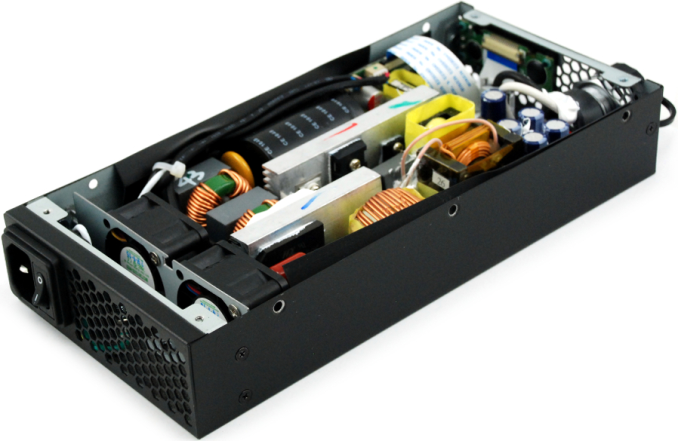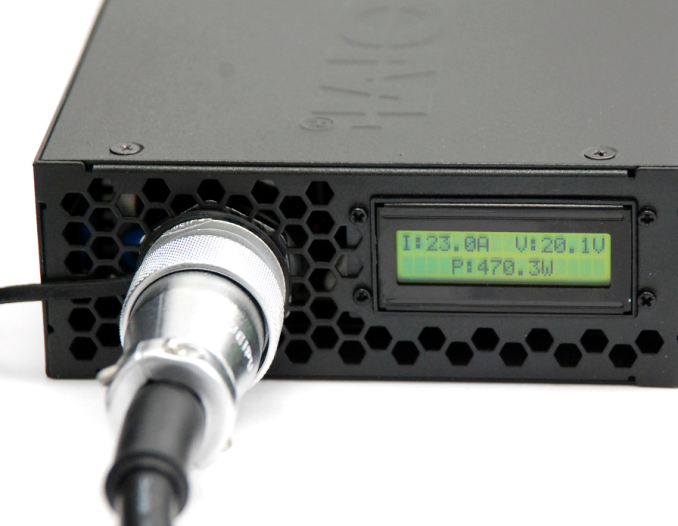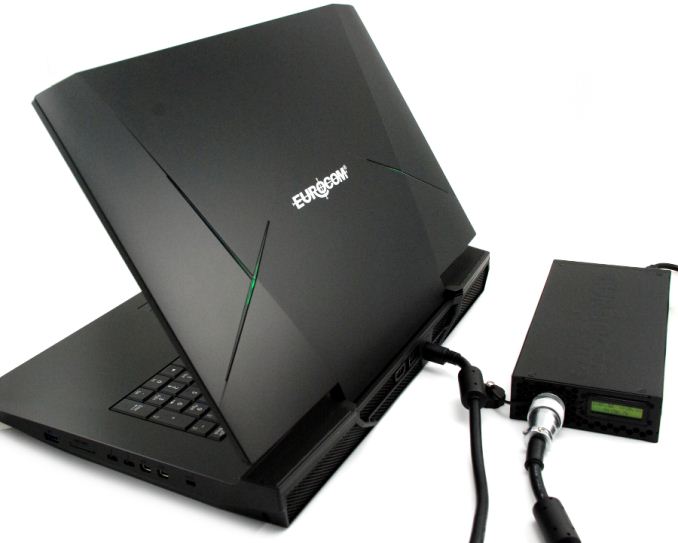Eurocom Launches a 780 W External PSU for Laptops
by Anton Shilov on February 11, 2017 11:30 AM EST- Posted in
- Cases/Cooling/PSUs
- PSUs
- Eurocom
- 780W

The world is getting mobile and many things that used to come in full-tower desktop chassis are now available in mobile form-factors. For example, high-performance notebooks from companies like Eurocom, Clevo or MSI can easily leave mid-range mainstream desktops behind in terms of performance - and yet these are laptops (albeit, not very portable ones). These machines typically come with a single large power adaptor, or in the case of a couple of models, two adaptors. To add to the market, Eurocom this week announced its new high efficiency 780 W power supply/AC/DC adapter.
The new Eurocom 780 W external PSU is designed for PCs that use a four-conductor DIN-type connector, which includes ultra-high-end laptops like Eurocom’s own Sky X9E2, Sky X7E2 as well as some notebooks from Clevo (including PCs that this manufacturer produces for other brands and which use the same power plug) and MSI. The power supply can also be used for other PCs including compact desktops/workstations/servers or even industrial systems used in rough conditions.
The 780 W external PSU (below that of high-end desktop PSUs) is rated for a 39 A maximum load, which is a very high load for laptops. Eurocom claims that efficiency of the 780 W external power supply is higher than 90% when measured with a nominal line and maximum load (the company does not mention environment temperature), but it is not 80 PLUS certified. To cool down the internal components, the device has two high-speed fans, which may mean noise. Finally, the PSU is equipped with a LED display that gives a real-time breakdown of the amperage, voltage and wattage currently used.
Eurocom’s laptops in certain configurations use two 330 W PSUs with a converter box, which is not very convenient. The new Eurocom 780 W AC/DC Adapter solves the problem to a degree, but keep in mind that the PSU alone will be big and heavy: it weighs 1.7 kilograms with the cable (3.75 lbs), it is 325 mm (12.8”) long, 40 mm (1.5") thick and is 110 mm (4.3”) wide.
The Eurocom 780W AC/DC Adapter is available from Eurocom for $475, which is slightly more than the price of two Eurocom’s 330 W PSUs ($413).
Related Reading:
Source: Eurocom



















23 Comments
View All Comments
Flunk - Saturday, February 11, 2017 - link
"The 780 W external PSU is rated for a 39 A maximum load (below that of high-end desktop PSUs)"This sentence doesn't really make sense. It's 39A because the power supply puts out 20V and 39 x 20 = 780 (shocking, I know). The AMP ratings you're thinking of on desktop supplies are probably on a 12V line. That doesn't mean that this is any less capable. Just that you don't understand the relationship between volt, amp and watts (W = A x V).
Valantar - Saturday, February 11, 2017 - link
My thoughts exactly. That sentence makes no sense at all. Were you comparing it to the A rating of the 12V rails of an ATX PSU? If so, that's a completely invalid comparison.The same goes for it not being 80+ rated. 80+ is a rating system for internal ATX power standard PSUs (outputting at the very least 12V+, 5V+, 3.3V+, 12V- and 5Vsb. That an external non-ATX PSU delivering a single 20V rail isn't certified by that standard is... well, not all that surprising.
Samus - Saturday, February 11, 2017 - link
Typically these are rated by class. Class II, Class IV, Class V, etc. Being 90%, it is Class V.Valantar - Monday, February 13, 2017 - link
So, in other words, it can't be sold in the US? The US mandates all external PSUs sold there to be class VI, after all (http://www.cui.com/catalog/resource/efficiency-sta...Actually, scratch that. From reading that document, the requirements for Class V is 87% average and =<.5W at no load, but that only applies to PSUs up to 250W. The Class I-V ratings don't go higher than that. Class VI mandates 88% average efficiency between 49 and 250W, 87.5% average efficiency at above 250W, and at most .5W under no load, for single-voltage AC-DC PSUs. Which places this PSU clearly in compliance with Class VI requirements. Sounds great to me! Of course, overall efficiency is all dependent on the efficiency of the DC-DC converters in the laptop in question too. But that's outside of anyone's control except for hardware manufacturers, unfortunately.
Samus - Tuesday, February 14, 2017 - link
All we have to go on is the manufacture claims, which are 90% efficiency, which is well beyond class IV. But I agree, it doesn't really qualify for classification efficiency because it is such a broadly unusual product. Most single voltage power supplies of this output simply are not rated, such as battery chargers, jumper boxes, voltage converters (typically DC to AC) and so on.But since it is a PC product and we are so used to a rating of sorts, I still feel it closely resembles Class V more than anything, but without the details of no load efficiency, as you said, it could very well be Class IV with a high efficiency at load.
Valantar - Thursday, February 16, 2017 - link
I think you misread my comment. Class I-V don't go higher than 250W, but class VI (i.e. 6, the most recent and highest rating) has a rating for ">250W" output power supplies (as well as other new classes like multi-voltage power supplies). Which this (given that its 90% efficiency claim is accurate) passes with flying colours. The US mandates all chargers sold there to fulfill Class VI requirements.close - Monday, February 13, 2017 - link
Well the comparison might not be apples to apples but this PSU is rated at 780W while many high end desktop PSUs are rated at a lot more. So "mathematics wise" 780W (39A at 20V) is equivalent to 780W (65A at 12V). With desktop PSUs putting out as much as 166A at 12V (almost 3 times as much) I think the remark is valid.This is probably the highest end laptop PSU on the market but it's still a far cry from high end desktop PSUs. Or at least this is what I read from that remark.
Valantar - Monday, February 13, 2017 - link
If read in that way, sure, the statement is valid. But what on earth is the point in effectively saying "This 780W PSU delivers less power than desktop PSUs rated for higher wattages"? Or more to the point: "This PSU delivers less power than more powerful PSUs." In what corner of the universe is that an even remotely useful statement? Of course it's a far cry from high end desktop PSUs. Is the 780W rating even remotely confusing in that regard?close - Monday, February 13, 2017 - link
Maybe to show that ultra-enthusiast laptop PSUs still lag behind high-end and mainstream desktop ones? It might have literally been just to state the obvious.I will try not to assume that an AT editor forgot that V is half of the P formula or that you can't judge a PSU only by its amps :).
vladx - Saturday, February 11, 2017 - link
Is there even a need for a 780W PSU? I think a 450W/500W would've been enough for any new laptop on the market.